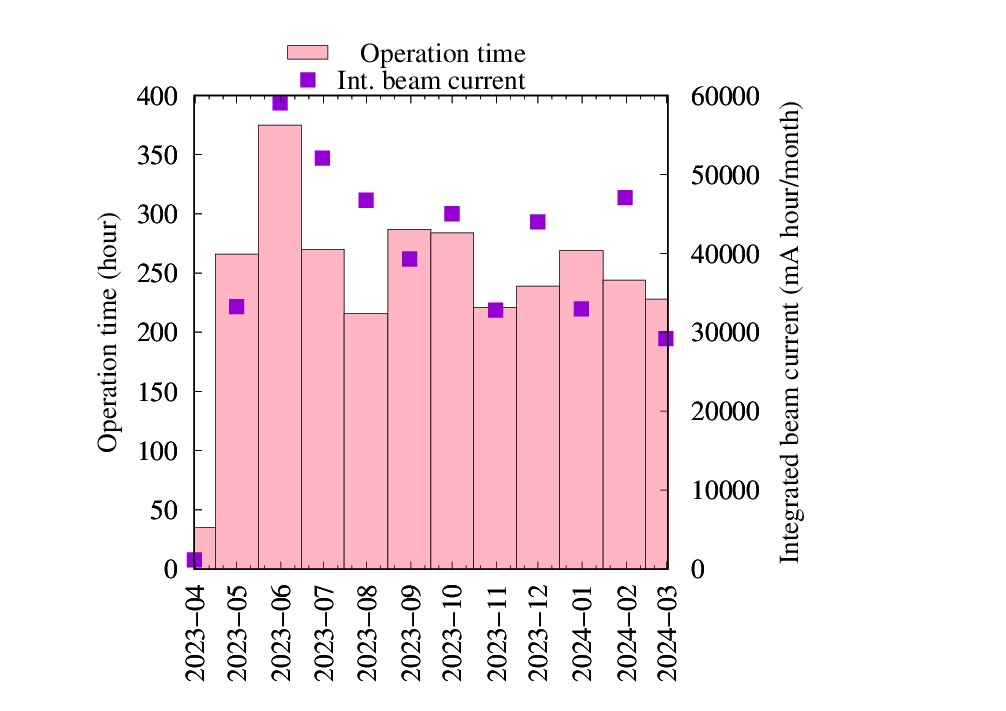In FY2023, UVSOR-III was operated for users as scheduled for 36 weeks from end of May 2023 to March 2024. Monthly statistics of operation time and integrated beam current are shown in Fig. 1. From the beginning of April to early May, during which periodic inspections were conducted. The two weeks following the shutdown were allocated to the adjustment of the accelerator and beamlines. The weekly operation schedule is as follows. Mondays are assigned to machine studies from 9:00 AM to 9:00 PM. User operation is assigned Tuesday through Friday, with Tuesday and Wednesday operating from 9:00 AM to 9:00 PM, and Thursday from 9:00 AM to 9:00 PM on Friday for 36 continuous hours. Thus, the user's beam time per week is 60 hours. Instantaneous voltage drops due to lightning strikes occurred frequently during the July-August period. This caused beam dumps, leading to loss of operation time. Several insulation breakdowns of the high-voltage charging cable of the pulse power supply for the synchrotron first kicker have occurred, but have been restored by replacing the cable. A malfunction of the S-band pulse amplifier for the linear accelerator occurred, but has been addressed by adjusting the amplifier gain. We are considering updating the S-band pulse amplifier due to concerns that the problem may recur. Injection efficiency of the electron beam into the storage ring started to decrease around January 2023. The injection efficiency is calculated as the ratio of the increase in the stored current value, I, to the current value passing through the transport line between the booster synchrotron and the storage ring. Under normal conditions, the injection efficiency was 60~70% and I was 0.4~0.6 mA/shot, but after January 2023, the efficiency dropped to 20~30% and I 0.1~0.3 mA/shot. The limited number of electrons that can be injected into the storage ring per week makes it difficult to continue 300 mA operation. Therefore, user operation has been conducted with the stored current value reduced to 200 mA since May 2023. Various investigations are continuing to determine the cause, but so far no clear cause has been identified. However, it has been confirmed that the quality of the electron beam extracted by the booster synchrotron has deteriorated. The vacuum ducts in the bending magnet section of the booster synchrotron have experienced multiple vacuum leaks, and there is concern that opening the ducts to the atmosphere may induce serious vacuum leaks, so it is currently impossible to visually check inside the ducts. All vacuum ducts in the bending magnet section are scheduled to be replaced with new ones in the spring of 2025. At that time, we will check the inside of the vacuum ducts of the booster synchrotron to see if there are any foreign objects that are scattering the beam. We started a design study for the future plan of UVSOR-IV. As a first step, we have analyzed the present magnetic lattice, seeking a possibility to reduce the emittance more [1]. Although, we did not find a solution to drastically reduce emittance, we have found a few interesting solutions that achieved lower emittance than the current situation. As the second step, we have started designing a totally new storage ring, which is close to the diffraction limit in the VUV range [2]. The light source development and utilization beamline BL1U, constructed under the support of Quantum Beam Technology Program by MEXT/JST, continue to develop new light source technologies and their applications such as free electron laser, coherent harmonic generation, coherent synchrotron radiation, coherent control [3], laser Compton scattered gamma rays [4, 5], and optical vortices [6].

Fig. 1. Monthly statistics in FY2023.
Yoshitaka TAIRA (UVSOR Synchrotron Facility, Institute for Molecular Science)